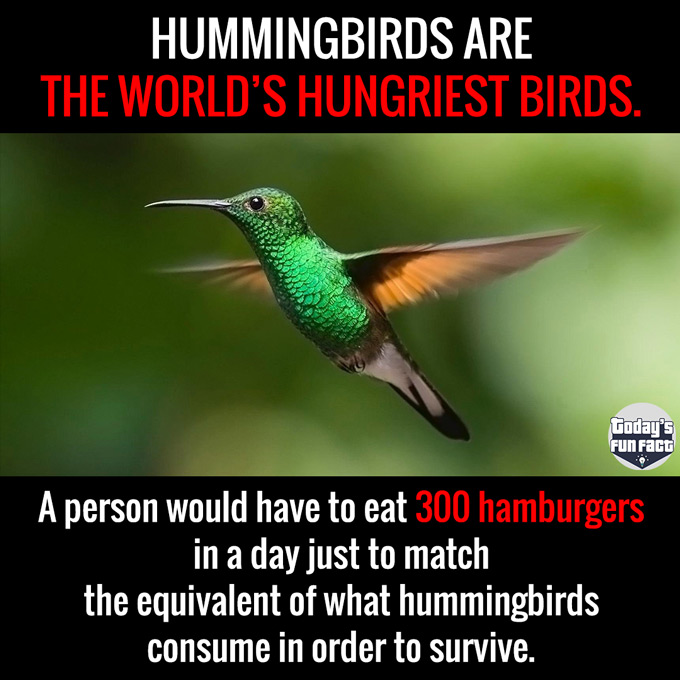
A Person Would Have To Eat 300 Hamburgers In A Day To Match What Hummingbirds Consume Graphic © todaysfunfact.com. Background photo: Pixabay (PD)
Hummingbirds hold the Guinness World Record for the “hungriest birds”—a well-deserved title. According to National Geographic, the amount of food the small but rapid birds eat daily to survive is the equivalent of a person gobbling up 300 hamburgers or cleaning out a refrigerator full of food.
Life In The Fast Lane
If you’ve spotted a hummingbird, you might have realized that everything about them appears to be on fast forward. A hummingbird’s unreal appetite stems from its high metabolic rates.
Here are some facts by the National Wildlife Federation to explain how the intriguing birds work out such a huge appetite:
• A hummingbird’s heart beats over 1,000 times per minute. This is 10X faster than a human heart.
• Hummingbirds are the speedsters of the bird kingdom. They flap their wings 50-200 times per SECOND. The blinding wing flapping speeds often hits peak during mate season. To the naked human eye, all you’d see is a buzzing blur.
• Hummingbirds take 250 breaths per minute—compared to our 16-20 breaths per minute.
Oh So Hungry
With their metabolic rates constantly on ‘overdrive,’ hummingbirds need to consume around 50% of their body weight in food daily to survive. Let’s put this into perspective:
The average American weighs 199.8 pounds (men) or 170.8 pounds (women). If we had the metabolic rate of hummingbirds, we would have to eat 85 – 100 pounds of food to survive. Mind you, a typical refrigerator holds around 60 pounds of food.
Unsurprisingly, a hummingbird can starve to death in hours—which is why they typically eat every 10 minutes or so. But what about nighttime when they have to sleep?
To make it through the night without starving, hummingbirds enter a state of torpor. This is a suspended state where body temperature and heartbeat are dialed down significantly to minimize the need for food.
Their diet consists of:
• Nectar: This is the most popular and most abundant source of food to fuel their high metabolism. In its quest for basic nutritional intake, a single hummingbird may visit a whopping 1,000 flowers in a day.
• Sap: No nectar? Tree sap is a decent alternative source of sucrose to meet a hummer’s energy needs.
• Small insects, spiders, larvae, and insect eggs are important food sources for protein, fat, and other nutrients hummingbirds can’t get from nectar.
• Fruit: You might find one seeping juice from exposed oranges, berries, and apples.
It’s probably helpful that a hummingbird’s brain is proportionately one of the largest among birds. They’ve been shown to memorize and recall food spots from the previous year. Such intriguing birds, right?
